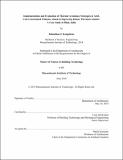| dc.contributor.advisor | Leon Glicksman. | en_US |
| dc.contributor.author | Kongoletos, Johnathan J. (Johnathan James) | en_US |
| dc.contributor.other | Massachusetts Institute of Technology. Department of Architecture. | en_US |
| dc.coverage.spatial | a-ii--- | en_US |
| dc.date.accessioned | 2018-10-15T18:37:14Z | |
| dc.date.available | 2018-10-15T18:37:14Z | |
| dc.date.copyright | 2018 | en_US |
| dc.date.issued | 2018 | en_US |
| dc.identifier.uri | http://hdl.handle.net/1721.1/118488 | |
| dc.description | Thesis: S.M. in Building Technology, Massachusetts Institute of Technology, Department of Architecture, 2018. | en_US |
| dc.description | This electronic version was submitted by the student author. The certified thesis is available in the Institute Archives and Special Collections. | en_US |
| dc.description | Cataloged from student-submitted PDF version of thesis. | en_US |
| dc.description | Includes bibliographical references (pages 150-155). | en_US |
| dc.description.abstract | The use of air conditioning in the buildings sector has been rapidly increasing. The International Energy Agency projects that rising income and greater access to air conditioning equipment in many developing countries will increase CO₂-equivalent emissions, energy consumption, and urban heat island effects. India is a prime example of a region where new building trends, hot climatic conditions, increasing social aspirations, and rapid population growth is likely to spread the adoption of air conditioning. To reduce the need for air conditioning, the research team has worked to develop, implement, and evaluate methods to reduce temperatures within the built environment using largely passive means. Building on the past work of Nelson and Gradillas, the thesis presents the results of long-term temperature monitoring within four homes in Bhuj, India. Results from the collective work have helped to inform future designs for the region, and resulted in an innovative roof concept. Using scale models, thermal simulations, and full-scale housing, results from the thesis explore new methods of implementing solutions for reduced solar heat gain, reduced heat absorption, and increased heat rejection. The research concludes by presenting early work on additional techniques and implications of using indigenous products to better thermal comfort conditions. Applicable outside of India, the techniques can be utilized in other regions and climates, as well as concurrently with active cooling systems to reduce energy consumption or extend existing capacity. Further work will seek to improve the design and adaptability of the system to different regions. | en_US |
| dc.description.statementofresponsibility | by Johnathan J. Kongoletos. | en_US |
| dc.format.extent | 155 pages | en_US |
| dc.language.iso | eng | en_US |
| dc.publisher | Massachusetts Institute of Technology | en_US |
| dc.rights | MIT theses are protected by copyright. They may be viewed, downloaded, or printed from this source but further reproduction or distribution in any format is prohibited without written permission. | en_US |
| dc.rights.uri | http://dspace.mit.edu/handle/1721.1/7582 | en_US |
| dc.subject | Architecture. | en_US |
| dc.title | Implementation and evaluation of thermal avoidance strategies in arid, cost-constrained climates aimed at improving indoor thermal comfort : a case study in Bhuj, India | en_US |
| dc.type | Thesis | en_US |
| dc.description.degree | S.M. in Building Technology | en_US |
| dc.contributor.department | Massachusetts Institute of Technology. Department of Architecture | |
| dc.identifier.oclc | 1054786452 | en_US |
